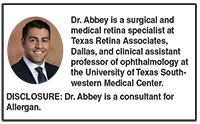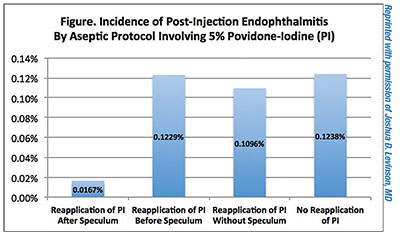 |
Here, we present summaries of five of the most intriguing presentations. They include long-term results of gene therapy for inherited retinal disease, assessing syringes used for bevacizumab injections for silicone oil droplets, the use of intravitreal sirolimus for recalcitrant neovascular age-related macular degeneration, an intravitreal injection protocol to reduce the risk of endophthalmitis and evaluating early vitrectomy for epiretinal membranes.
Four-Year Results: Gene Therapy for IRD
The treatment of inherited retinal diseases has perplexed the retina community for decades. Fortunately, there appears to be significant promise with the use of viral vectors for gene therapy in these patients. In this study, voretigene neparvovec (VN, Luxturna, Spark Therapeutics), an adeno-associated viral type 2 vector that drives expression of hRPE 65, was administered to eyes of patients with RPE65-mediated inherited retinal disease. An initial Phase I study evaluated single-dose subretinal administration of VN in the eye with worse vision.
This follow-up study presented four-year results after subretinal administration of VN 0.3 ml in the second, previously uninjected eye of 11 patients.1 Subjects were then tested for ability to navigate in varying light levels through multi-luminance mobility testing (MLMT) and full-field, light-sensitivity threshold testing (FST).
Four-year data for eight of the 11 patients was presented. After treatment, MLMT improved rapidly and was sustained at four years. FST also demonstrated a rapid improvement after treatment. Compared with baseline, there was a hundredfold improvement of FST at 30 days, which was sustained over four years. There were no serious adverse events associated with VN, nor were there any reported immune responses.
The sustained improvement in visual function after treatment with this viral vector marks a significant step toward effectively treating RPE65-mediated inherited retinal disease. Subretinal gene therapy using viral vectors continues to show promise for a number of inherited retinal diseases for which we do not have any efficacious treatment.
The study author disclosed being an investigator for and grant recipient of Spark Therapeutics.
Silicone Oil Droplets More Common With BD Insulin Syringes
In 2016, the ASRS received an unusually high number of adverse event reports regarding symptomatic silicone oil droplets in the vitreous cavity after bevacizumab injections. This study attempted to determine if the commonly used Becton Dickenson (BD) insulin syringes were more likely to result in oil droplets being injected into the vitreous.2 This study evaluated four different types of syringes: BD insulin syringes; BD tuberculin syringes; Henke Sass Wolf (HSW) insulin syringes; and HSW silicone-free syringes.
Twenty of each type of syringe were loaded with 0.06 mL of fluorescein and incubated at 40° C for two to four weeks. Subsequently, the syringe fluid was ejected onto slides and examined microscopically.
Silicone oil droplets were identified in five (25 percent) of the BD insulin syringes. No oil droplets were found in any of the other syringes. The oil droplets also occurred when the plunger was maximally depressed with the fixed-needle design. The study also found that syringes that lack dead space are more susceptible to silicone oil droplets being injected into the vitreous.
This important study identifies a higher risk of silicone oil droplets with injections using BD insulin syringes, particularly with a lack of dead space in the syringe. Retina specialists should carefully consider the type of syringe that their compounding pharmacy is using in order to avoid this potential complication.
The study author had no relevant disclosures.
Aseptic Protocol to Reduce Endophthalmitis Risk After IVT
The application of povidone-iodine is known to be the most critical measure that can be taken to prevent endophthalmitis after intravitreal injection (IVT). This study identified one key step that significantly reduced the risk of endophthalmitis in patients receiving injections: applying PI after placement of the lid speculum.3
This retrospective study of 37,646 intravitreal injections used a multivariate analysis to identify risk factors for development of endophthalmitis occurring after injection. Before all injections, a technician applied 5% PI t
 |
Thirty-three cases of endophthalmitis were identified for an overall incidence of 0.088 percent (Figure). The first three groups had very similar incidences of endophthalmitis (0.124 percent, 0.110 percent and 0.122 percent, respectively). However, the fourth group, which reapplied PI after insertion of the lid speculum, was associated with a significant reduction in the incidence of endophthalmitis (0.017 percent, p=0.004).
This study suggests that contact from the eyelid to the injection site after final application of PI may significantly increase the risk of post-injection endophthalmitis. The application of PI after insertion of a lid speculum appears to provide a substantial safety benefit for intravitreal injections.
The study authors had no relevant disclosures.
Sirolimus with Aflibercept Vs. Aflibercept Monotherapy
Intravitreal injection of sirolimus (Santen) in conjunction with aflibercept (Eylea, Regeneron) leads to better anatomical outcomes on optical coherence tomography in patients with chronic exudative AMD compared to aflibercept monotherapy. Sirolimus inhibits the mammalian target of rapamycin (mTOR), which has been shown to be involved in inflammation, angiogenesis, fibrosis and hyperpermeability. In a previous study, the authors compared sirolimus monotherapy to standard anti-VEGF treatment for chronic neovascular AMD and found a significant decrease in central subfield thickness in the sirolimus group compared to an increase in the standard anti-VEGF group.
In this study, the authors aimed to determine if combination treatment with sirolimus and aflibercept would be beneficial for chronic exudative AMD.4 They performed a prospective, randomized study of patients with persistent intraretinal or subretinal fluid despite appropriate treatment with anti-VEGF agents for exudative AMD. Group 1 (10 patients) received intravitreal injections of sirolimus (440 μg) at baseline, and week four, 12, 20 and 28, and aflibercept at weeks one, eight and 16. Future aflibercept injections were based on the persistence of fluid. Group 2 (10 patients) received aflibercept at baseline, weeks eight, 16, 24 and 32.
After nine months, group 1 demonstrated a better anatomical response, but no statistically significant difference in visual acuity changes was noted between the two groups. The presence of baseline chronic fluid may have precluded more robust gains in visual acuity in group 1 despite the better anatomical outcomes.
This study suggests that intravitreal injection of sirolimus may be an effective adjuvant therapy for recalcitrant neovascular AMD. Larger studies with earlier use of sirolimus will be useful to determine if this combination therapy could result in better long-term visual outcomes and reduced injection burden compared to anti-VEGF monotherapy.
The lead author disclosed being a consultant to Santen. Four co-authors had no relationships to disclose.
When Should ERMs Be Removed?
Modern small-gauge surgical techniques are more likely to preserve vision when epiretinal membrane (ERM) removal is performed sooner rather than after a significant decline in vision below 20/40. The authors performed a retrospective chart review of 119 pseudophakic eyes that underwent vitrectomy and ERM/internal limiting membrane peeling for idiopathic ERM.5 Twenty-four of 27 (89 percent) eyes with preoperative vision ≥20/40 attained final postoperative vision of ≥20/40, while only 52 of 88 (59 percent) eyes with preoperative vision ≤20/50 attained ≥20/40 vision at final postoperative vision.
Vitreoretinal surgeons often use the arbitrary vision threshold of 20/40 when deciding to operate on an ERM. This study indicates that the removal of an ERM prior to a significant decline in vision below 20/40 may increase the likelihood of achieving final postoperative vision of ≥20/40. These findings may motivate surgeons to operate sooner on symptomatic patients with epiretinal membranes. Larger studies are needed to validate this intriguing finding.
Take-home Point
This article explores five noteworthy presentations from the American Society of Retina Specialists 37th annual meeting: a readout of four-year results of gene therapy for RPE65-mediated inherited retinal disease; a study of different syringes and their proclivity for leaving residual oil droplets; a comparison of sirolimus and anti-VEGF therapy vs. anti-VEGF monotherapy; how an aseptic protocol may reduce endopthalmitis risk after intravitreal therapy; and a study of epiretinal membrane removal before vision declines below 20/40. RS
The lead author had no relationships to disclose. A co-author disclosed relationships with Covalent Medical, Dutch Ophthalmic Research Center (DORC) and Vestrum Health.
REFERENCES
1. Maguire AM. Year 4 results for a Phase I trial of voretigene neparvovec in biallelic RPE65-mediated inherited retinal disease. Paper presented at: 35th annual meeting of the American Society of Retina Specialists; August 15, 2017: Boston, MA.
2. Emerson GE. Silicone oil droplets are more common in fluid from BD insulin syringes as compared to other syringes. Paper presented at: 35th annual meeting of the American Society of Retina Specialists; August 14, 2017: Boston, MA.
3. Levinson JD. An aseptic protocol to reduce the risk of endophthalmitis following intravitreal injection. Paper presented at: 35th annual meeting of the American Society of Retina Specialists; August 13, 2017: Boston, MA.
4. Maturi RK, Chhablani J, Harless A, Japeen A, Bracha P. Sirolimus in conjunction with aflibercept vs. aflibercept monotherapy for the treatment of chronic exudative AMD. Paper presented at: 35th annual meeting of the American Society of Retina Specialists; August 14, 2017: Boston, MA.
5. Par G, Pollack JS. Should epiretinal membranes be removed before vision drops below 20/40? Paper presented at: 35th annual meeting of the American Society of Retina Specialists; August 12, 2017: Boston, MA.



